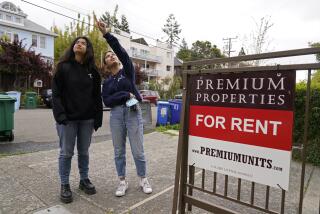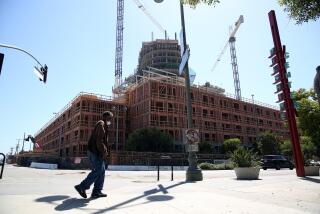U.S. housing starts tumble
WASHINGTON — Housing construction plunged to the lowest level in nearly a decade last month as the housing industry continued to struggle with a severe slowdown.
Meanwhile, wholesale prices fell 0.6% in January, the biggest drop in three months, providing fresh evidence that inflation pressures were easing.
Construction of new homes and apartments plunged by 14.3% in January, pushing total activity down to a seasonally adjusted annual rate of 1.408 million units, the Commerce Department reported Friday.
The decline pushed activity to the slowest pace since August 1997, with construction in January 37.8% below the pace of a year earlier. The steep decline last month followed two months of construction increases that had raised hopes that perhaps the worst of the housing slump was over.
The weather was blamed for part of the setback. November and December had been unusually mild, but more normal winter weather returned to much of the country in January, depressing building activity.
However, economists said the depth of the decline showed that the housing sector was still facing major problems after a five-year boom that ended last year with falling construction and declining sales of both new and existing homes.
David Seiders, chief economist of the National Assn. of Home Builders, said builders were slashing prices and offering other incentives such as upgraded kitchens and free decks to move homes.
“The use of incentives has not abated,” he said. “The percentage of builders trimming prices has been increasing and the use of non-price incentives is expanding as well,” he said.
The housing report showed that applications for new building permits, considered a good barometer of future activity, fell in January for the 11th month out of the last 12, dropping by 2.8% to an annual rate of 1.568 million units.
By region, housing construction was down 28.5% in the West, 15.2% in the Midwest and 11.8% in the South. Construction starts were up only in the Northeast, which saw a gain of 8.9%.
Analysts said the weakness in January construction meant that housing, which shaved more than a percentage point off economic growth in the last half of 2006, would continue to be a drag going into the new year.
In the inflation report, the Labor Department said that the 0.6% drop in its producer price index was the biggest one-month decline since a 1.8% fall in October.
The decline last month occurred because of a 4.6% plunge in energy costs, reflecting lower prices for gasoline, natural gas and home heating oil.
But even outside of the volatile energy and food categories, inflation was well contained at a modest 0.2% as the price of new cars and trucks fell as automakers struggled with huge inventories of unsold cars.
Federal Reserve Chairman Ben S. Bernanke told Congress this week that the central bank believed that inflation pressures would gradually recede over the coming two years as the economy expanded at a moderate pace.
Many private economists believe the central bank is close to achieving its hoped-for soft landing, in which growth slows enough to keep inflation contained without pushing the country into a recession.
More to Read
Inside the business of entertainment
The Wide Shot brings you news, analysis and insights on everything from streaming wars to production — and what it all means for the future.
You may occasionally receive promotional content from the Los Angeles Times.










